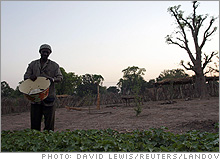BP's answer to food-based ethanolThe oil giant believes an inedible plant called jatropha can ease global fuel demands. It could boost incomes in Africa and other impoverished regions too.(Fortune Magazine) -- Can a poisonous plant become a biodiesel hero and help African economies in the process? BP (Charts) thinks so. It believes jatropha - an inedible plant used for hedges that was spread around the world centuries ago by Portuguese sailors - can dent global fuel demands without using up foodstuffs such as corn, soy and sugar cane, plus boost incomes in Africa and other impoverished regions.
In June the oil giant signed a $160 million deal with British biodiesel producer Dl Oils, creating a joint venture that aims to become the world's largest producer of jatropha oil by 2011. The new company expects to have nearly three million acres under cultivation within four years and process roughly two million tons annually - or 18% of Europe's expected biodiesel demand. "The deal with Dl is all about developing a biofuels business," says BP spokeswoman Wendy Silcock. Half of the 12 countries targeted for bulk plantings are in Africa. Because it can grow year-round in arid soil and is inedible, jatropha won't innate food prices or take up valuable cropland. Africa is considered ideal because of its proximity to European markets and low land and labor costs. "Jatropha is low input," says Steve Douty, executive director of Dl Oils. "It survives where others don't. It also grows best 25 degrees south or north of the equator. A big chunk of Africa is in that band." In addition, Jatropha oil can be produced commercially within three years of planting, compared with seven years for palm oil; plus, it is a living fence that keeps cattle in and sand out and can survive for 50 years. Best of all, jatropha seeds generate up to 40% of their weight in oil with ample fertilizer and water, and 30% even in scrubland - far more than soybeans' 18%. Jatropha sap has long been used in Latin American medicines for its antibacterial qualities. The seed is used for fertilizer in Africa because it is rich in soil nutrients, and the oil is used for French soaps. But pressing oil from its seeds for energy is recent, and current production is negligible. Today jatropha accounts for less than 1% of biodiesel fuel. High oil prices and the rising cost of food oils make jatropha attractive - as does a looming European mandate requiring that 10% of all transport fuel be biofuel by 2020. Global biodiesel output needs to grow more than ninefold to meet that demand. Jatropha is becoming popular elsewhere as well. Energy-starved India led research into jatropha and is believed to have nearly 250,000 acres under cultivation. China reportedly has 100 times that. And in July, SE-Energy Technology announced it will build the largest U.S. biodiesel plant, using primarily jatropha, in Chesapeake, Va. Even private equity is getting in on the act, says Turi Munthe, a London investor who is raising funds for a 124,000-acre jatropha plantation in Ghana. "Africa is the place for it." |
Sponsors
|

